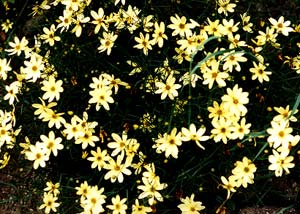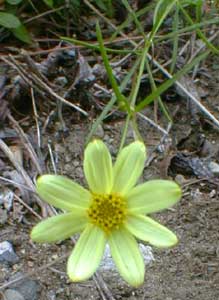
Moonbeam Coreopsis
aka Threadleaf
aka Tickseed
Coreopsis verticillata 'Moonbeam' is called Threadleaf because its leaves are almost as wirey as the flower stems, or Tickseed because of the appearance of the black seeds, the scientific name Coreopsis also alluding to this appearance, having the whimsical meaning "Looks Like a Bug."
The airy slender foliage makes it a good choice for a crowding fill-in plant amidst other sun-loving perennials, for it will not shade anything. It is a cultivar of a native species with its natural range from Maryland to Florida, inland to Arkansas. It was introduced to London gardeners in 1759.
The species, but not this cultivar, naturalizes easily. The cultivar 'Moonbeam' is sterile so propagation is by division or cuttings. It can be dug up every few years & divided into multiple plants. That is, if it survives more than a couple of years. It blooms so wholeheartedly for so long that it has a tendency to just wear itself out after two years.
 It prefers a great deal of sun & requires right watering or attention. It produces masses of butter-yellow daisy-like flowers which last all summer & well into autumn. The photo above left is from September (2002), but could just as easily be a July photo. That it provides such bright yellow in the sun-garden for so long is its greatest strength.
It prefers a great deal of sun & requires right watering or attention. It produces masses of butter-yellow daisy-like flowers which last all summer & well into autumn. The photo above left is from September (2002), but could just as easily be a July photo. That it provides such bright yellow in the sun-garden for so long is its greatest strength.The flowers are suitable for bouquets. Deadheading is a nuisance with so many flowers, but bloom time is supposed to be extended to first frost if one makes the effort. I say "supposed to be" because I did a little experiment deadheading one & not deadheading the others, with the result that the one repeatedly deadheaded actually seemed stressed & stopped blooming in September, while the ones I never deadheaded were still blooming in October. The one I'd been deadheading died in winter. Perhaps that outcome was a meaningless fluke, but I'd never bother deadheading them again, despite the literature's assertion that its long bloom time can be considerably shortened if one fails to do so. The late autumn & early winter appearance is more interesting with the "tickseed" element intact anyway, with the wiry stems concluding in tiny soft black balls.
Threadleaf remains a wiry evergreen through mild or warm winters, but should be cut to the ground before new spring growth begins. Ours have not proven to be particularly evergreen, but turned two-thirds black at start of winter, the Northwest perhaps being a tad below its ideal temperatures to have a good winter presence; or more likely, our heavy autumn & winter rains stress it. Where it is evergreen, with so many perennials dried up or vanished in winter, threadleaf's lingering presence would be helpful in keeping life in the winter garden. Although it must be confessed, from any distance it is almost invisible when not in flower, the foliage being so extremely slender.
If it has drawbacks these would include the fact that it lacks any particular scent; & no matter how bushy it gets it always looks thin. Also, its sterility may be a drawback for some. 'Moonbeam' was selected as the 1992 Perennial Plant of the Year, an honor bestowed by the Perennial Plant Association, a trade organization. This organization likes especially to honor pretty things that are easy to cultivate en masse for the nursery trade, but which don't reproduce too easily for gardeners, thus perpetuating reliance on the nursery trade.
The fact that Moonbeam's seeds are sterile can be a plus if one does not want tickseed flowers spreading through the garden. Then again, given that C. verticillata tends to be a shortlived perennial, the sterility of 'Moonbeam' increases the likelihood of its decline, & it should probably be regarded as a transient presence in the garden. If naturalizing would be desireable, any other Coreopsis would be preferred; for example, the next most popular variety, 'Zagreb,' is a bit more compact, & is a self-seeding perennial.
In our xeriscape garden the clumps became thinner with each year. They attempt to flower even beyond winter frost, & have at least a small remaining presence in winter; this seems to put it at risk of freezing to death or being rotted out by fall & winter rainfall.
It was most floriferous its first year, fairly floriferious its second year though one clump had not returned after its first winter; & there was only a small remnant sign of it left for the third year when it did not flower at all. In the fourth year (2004) it produced a quarter-dozen blooms in a tiny fragment of what remained of the planting. The first bloom for this poor showing can be seen in the second portrait above right, snapped in July.
It would probably have continued to do well if it had had richer soil in a regularly watered location, but in the xeriscape garden it has faded year by year. I have no immediate intent to plant it again, & may never do so, even though for flower-power especially during that first year, it was quite amazing.